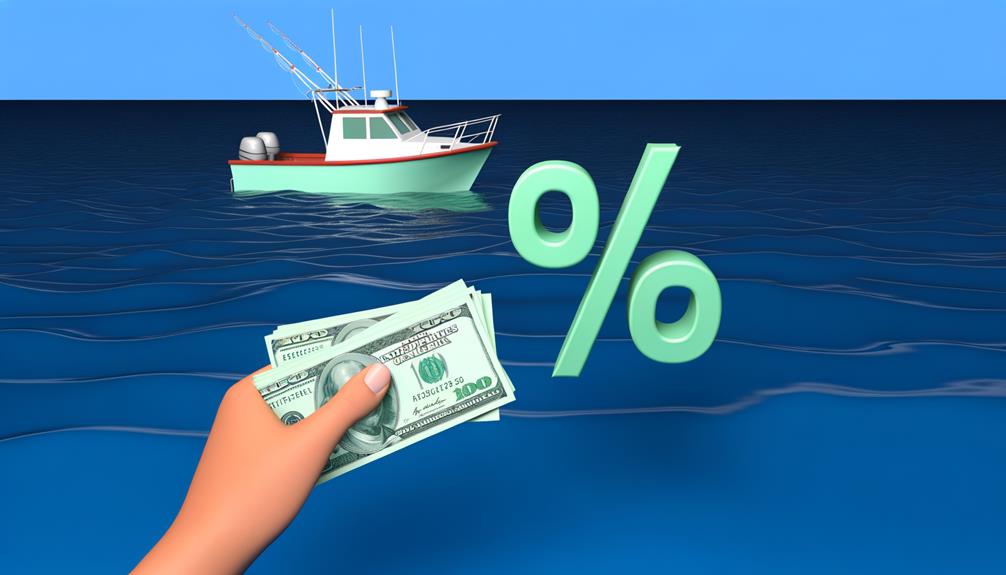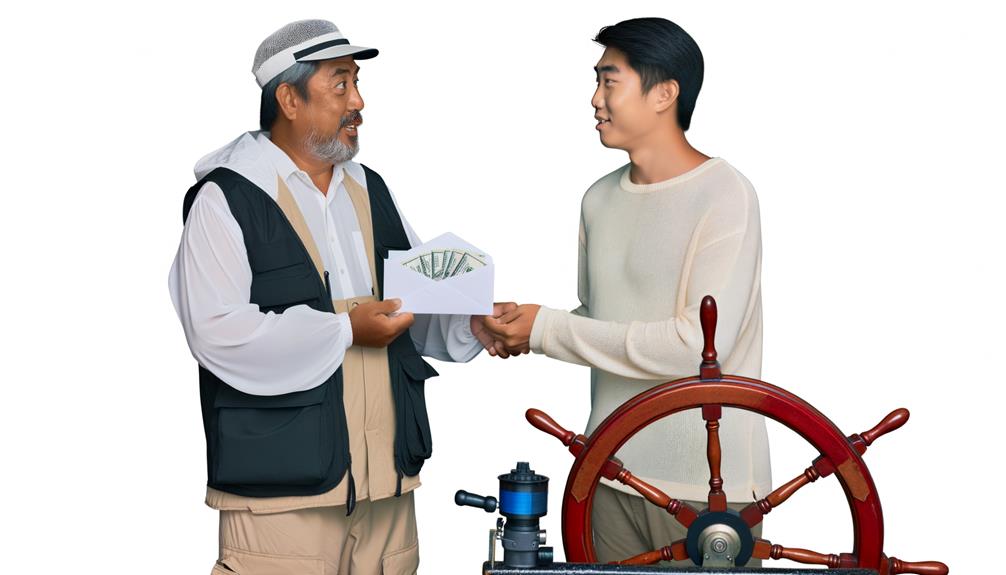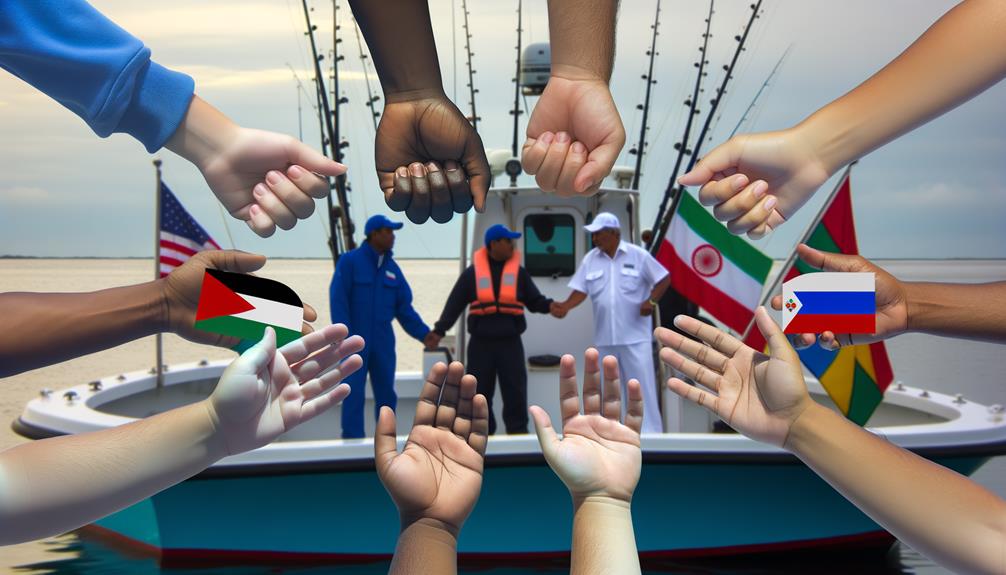How much do you tip fishing charters
In the sphere of recreational angling, the topic of tipping fishing charters often sails into murky waters. A custom steeped in gratitude and respect, how much to tip your first mate or crew can be a surprising conundrum, with a multitude of factors such as location, type of trip, and service quality clouding the decision-making process.
As we navigate through these considerations, we will also cast our nets wider into the cultural nuances that influence tipping practices around the globe. So, whether you’re a seasoned angler or a novice setting sail on your first charter fishing trip, this discussion aims to clear those waters, ensuring you’re neither short-changing your hardworking crew nor tipping over the odds.
Key Takeaways
- Tipping on fishing charters is customary and reflects appreciation for the guides and crew’s time, effort, and attention.
- The typical tipping range on fishing charters is 10-20% of the total charter cost, with 15% being a common starting point.
- Factors such as satisfaction with the trip, dedication and effort of the guide, personal affordability, crew setup, location, and number of people on board can influence the tip amount.
- It is important to inquire about tipping procedures and consider tipping each individual on the boat to acknowledge their contribution.
Understanding Tipping Etiquette
Navigating the intricacies of tipping etiquette on fishing charters requires a clear understanding of some fundamental guidelines. This includes knowing the percentages typically given, understanding the purpose of the tip, and considering the factors that influence how much and to whom it should be given.
The question of ‘How Much To Tip’ often arises, and a general rule is to give 10-20% of the charter cost. Starting at 15% is common, and the amount can be adjusted based on the satisfaction derived from the trip.
However, understanding tipping etiquette extends beyond just monetary considerations. It is crucial to acknowledge that your tip appreciates the time, effort, and attention of the guides and crew, rather than solely the quantity of fish caught. By doing this, you place value on their professional expertise and create a sense of belonging and appreciation.
It is also important to consider that different types of fishing trips may have varying boat and crew setups, and this can affect tipping dynamics. Factors such as location and crew setup should be taken into account when deciding how to tip. Additionally, determining whether to tip your guide individually or as a lump sum to the boat can help avoid any confusion.
Lastly, it is worth noting that leaving no tip may negatively impact your reputation within the fishing community. If you are dissatisfied with the trip, it is better to leave a 10% tip and address your concerns with the captain directly.
Factors Influencing the Tip Amount
When determining the appropriate tip amount for a fishing charter, several critical factors should be considered, including the level of satisfaction with the trip, the dedication and effort of the guide, and your personal affordability. The general rule for tipping fishing charters is 10-20% of the total cost. However, this percentage may be adjusted based on your overall experience and the guide’s commitment to making the trip enjoyable and successful.
Tipping is not merely for the fish caught but appreciates the guide’s time, effort, and attention during the trip. Thus, it’s crucial to factor in the guide’s dedication and effort when you tip well.
Additionally, the tipping dynamics may vary based on the crew, location, and the number of people on board. Different types of fishing trips may have varying boat and crew setups, which can affect the factors influencing the tip amount.
| Factor | Description |
|---|---|
| Satisfaction with the trip | Did the trip meet your expectations? |
| Dedication and effort of the guide | How hard did the guide work to ensure a successful trip? |
| Personal affordability | Can you comfortably afford to tip? |
| Crew, location, and number of people on board | Does the trip require a larger crew or more resources? |
Standard Tipping Rates in Charters

The general guideline for tipping on fishing charters is typically between 10-20% of the total charter cost, with 15% often acting as a starting point. However, this amount can be adjusted based on the quality of the service, the effort put forth by the guides and crew, and the overall satisfaction of the outing.
It’s also worth noting that different fishing trips have varying crew setups and the dynamics of tipping may fluctuate depending on these factors, the location of the charter, and the number of people on board.
Understanding Charter Tipping Norms
Grasping the customary norms of tipping in fishing charters, which typically range from 10-20% of the total cost, is essential for acknowledging the effort, time, and attention provided by the crew and guides. When it comes to tipping on fishing trips, understanding these norms can facilitate a smoother experience and foster a sense of community.
A good starting point for tipping is 15% of the total cost. The tip reflects the service quality, not the quantity of fish caught.
Boat and crew setups vary, influencing tipping norms. Inquire about tipping procedures to avoid confusion.
Factors Affecting Tip Amounts
Having understood the general norms of charter tipping, it is equally vital to delve into the factors that can influence these standard tipping rates, including crew composition, geographical location, and the number of passengers onboard.
The factors affecting tip amounts are diverse. For instance, a larger crew may necessitate a larger tip, especially if their service has been exceptional. Similarly, in certain locations where the cost of living is high, tipping generously may be the norm.
The number of passengers can also affect how much do you tip fishing charters. If the group is large, the crew’s effort in providing individual attention and ensuring everyone’s safety and satisfaction is significantly higher. In such cases, a tip reflecting their hard work and dedication is highly appropriate.
Role of Fishing Guides and Staff
On any fishing charter, a variety of roles from the captain to the deckhands play a significant part in ensuring a safe and successful trip, with tipping often serving as a tangible measure of customer satisfaction and appreciation.
The role of the fishing guide and staff is multifaceted, demanding a combination of skills to ensure a seamless experience for the guests. The following list outlines some key roles:
- Captains are responsible for the safe operation of the charter, navigating the waters, and finding the best fishing spots.
- Fishing guides provide personalized assistance to guests, including teaching effective fishing techniques, answering questions, and ensuring a memorable experience.
- Deckhands perform a variety of tasks such as baiting hooks, cleaning fish, and maintaining the boat.
- Support staff ensure that the charter runs smoothly, from scheduling to customer service.
When tipping, it’s best to tip individually, acknowledging each person’s contribution to your experience. Generally, the recommended tip is 10-20% of the charter cost, which is distributed among the crew. Remember, tips are not just about money; they’re a way of expressing gratitude for the hard work and dedication of the fishing guides and staff.
Importance of Cash Tips

While the role of fishing guides and staff is integral to a successful charter, the significance of cash tips in acknowledging their effort and dedication cannot be overstated. Cash tips are preferred in the fishing charter industry as they provide immediate financial support, ensuring that the service providers are adequately rewarded for their toil and expertise. Tipping in cash also guarantees that the reward goes directly to the guides and crew, acknowledging the personal touch they bring to the fishing experience.
Moreover, cash tips are crucial for fishing guides who often rely on these tips to supplement their income and cover daily expenses. Your tip represents a tangible appreciation of their hard work and the exceptional service they deliver. It becomes a vital part of their livelihood, making your fishing adventure possible.
Lastly, the act of giving cash tips is a classic, respectful way of acknowledging the dedication of these professionals. It underscores the unique bond forged during the trip, fostering a sense of belonging and mutual respect.
Therefore, when considering the tip for your next fishing charter, remember the value and importance of cash tips.
Tipping for Exceptional Service
In the realm of fishing charters, demonstrating gratitude for exceptional service typically manifests as a generous tip, typically ranging from 10 to 20% of the charter cost. This practice is more than just a social norm; it is a tangible way of acknowledging the hard work and dedication of your guides and crew. When their efforts elevate your fishing trip from merely good to truly remarkable, a generous tip serves as a fitting tribute.
However, determining what constitutes ‘exceptional service’ can be subjective. Here are some factors to consider:
- Was the crew attentive, helpful, and professional throughout the trip?
- Did they go above and beyond in ensuring your comfort and safety?
- Were they knowledgeable and willing to share insights about fishing techniques, species, and local lore?
- Did they enhance your overall experience, making the trip more enjoyable and memorable?
Tipping Practices Around the World

Tipping customs on fishing charters can vary vastly from one region to another, influenced by different cultural etiquettes and norms. It is therefore essential for anglers to understand these global tipping norms to ensure respectful and appropriate interactions with crew members.
The following discussion will explore regional variations in tipping, shedding light on these diverse practices around the world.
Global Tipping Norms
Often, the etiquette surrounding gratuity for fishing charters can vary significantly from country to country. In some places, tipping your guide is an essential part of the day on the water. It is more than just a courteous gesture, as these tips often help fishing guides and crew members pay their bills.
- In the United States, it is common to tip 15-20% of the total cost of the trip.
- Australian fishing charters rarely expect tips, but they are appreciated.
- In Canada, tipping is customary, usually around 15%.
- European countries often include service charges, but additional tipping is appreciated.
Cultural Etiquettes in Tipping
While it’s universally acknowledged that gratuities serve as a token of appreciation for services rendered, the specific practices and expectations for tipping fishing charters can vary remarkably across different cultures and countries.
In many places, a tip of 10-20% is customary, signifying to one guide that their job was well done, irrespective of the day’s catch. It is crucial to remember that tipping reflects your acknowledgment of their hard work and dedication, making even an unsuccessful fishing day a good day.
Leaving no tip at all can tarnish your reputation within the fishing community, so even if you are dissatisfied, a minimum 10% tip is advisable.
Always remember, the tip you leave is a direct reflection of your appreciation for the service received.
Regional Variations in Tips
Building on the discussion of cultural etiquettes in tipping, it’s important to consider the regional variations that exist in tipping practices across the globe. The customary amount can fluctuate significantly based on location and cultural norms.
In North America, a day of fishing often ends with a 15-20% tip.
In parts of Asia and Europe, you might hear, ‘I’ve never tipped for a charter,’ as tipping isn’t always customary.
In Australia, tipping was quite uncommon years ago but is growing in prevalence.
In South America, tipping is usually at the discretion of the guest, with no set standard.
Understanding these regional differences can enhance your fishing experience, helping you navigate cultural expectations while ensuring fair compensation for your crew.
Frequently Asked Questions
What Is an Appropriate Tip for a Fishing Charter?
An appropriate tip for charter experiences reflects tip etiquette and regional differences. Generally, a 15% gratuity of the total cost is standard, adjusted based on service quality. Be sure to inquire about tip distribution methods.
What Is the Customary Tip for First Mate?
The customary tip for a first mate, who has undergone extensive training and has numerous responsibilities, typically ranges around 20% of the charter price. This is in addition to their standard salary and is greatly appreciated for their hard work. The First Mate is always working hard to ensure you have a great day on the water catching fish on your day trip.
Do You Tip a Boat Captain?
Yes, tipping a boat captain is customary. It recognizes their responsibilities for safety, navigation, and overall trip enjoyment. Despite their salary, tipping showcases an appreciation for their service, adhering to established maritime tipping etiquette.
Do Fishing Charters Make Money?
Fishing charters generate income through client fees and tips. Charter profitability depends on multiple factors including revenue sources and operating expenses such as maintenance, fuel, crew salaries, and fishing equipment. Profitability varies widely across different charters.
Conclusion
In conclusion, navigating the practice of tipping fishing charters involves understanding etiquette, gauging the quality of service, and considering numerous influencing factors. A standard 10-20% tip reflects appreciation for the crew’s hard work and dedication. Cash tips are particularly beneficial, underlining the significance of personal recognition. Global practices vary, reinforcing the need for respectful inquiry. An exceptional service merits an extraordinary tip, underscoring the vital role of gratuity in acknowledging effort and enhancing the fishing charter experience.
